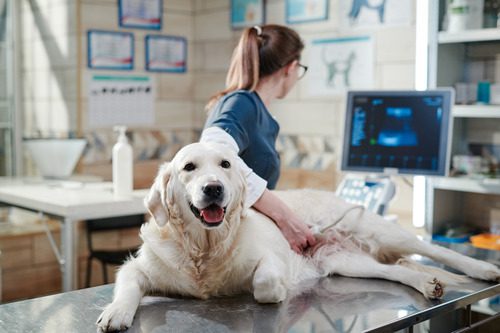Skin Cancer in Dogs: Signs to Look Out For
Skin cancer in dogs is a serious condition that pet owners need to be aware of. Just like humans, dogs can develop various forms of skin cancer that, if left untreated, can have significant health impacts. Understanding the signs to look out for can help ensure early detection and treatment, improving the prognosis for your beloved pet. At Keystone Animal Hospital in Bradenton, FL, we are committed to providing the best care for your pets. If you notice any unusual changes in your dog’s skin, call us today at (941) 741-8445.

Types of Skin Cancer in Dogs
Skin cancer in dogs can manifest in several forms, each with unique characteristics and implications. Knowing the different types can help you recognize potential issues early.
Malignant Melanoma
Malignant melanoma is a type of skin cancer in dogs that originates from pigment-producing cells called melanocytes. These tumors can appear anywhere on the body but are most commonly found in the mouth, toes, and eyes. Malignant melanomas are typically dark in color, though they can also be colorless. They are aggressive and can quickly spread to other parts of the body.
Squamous Cell Carcinoma
Squamous cell carcinoma is another common form of skin cancer in dogs. This type originates from the squamous cells in the skin and mucous membranes. Squamous cell carcinomas often appear as firm, raised masses that may ulcerate and bleed. They are frequently found on areas of the skin exposed to sunlight, such as the abdomen, eyelids, and nose.
Mast Cell Tumors
Mast cell tumors are the most common type of skin cancer in dogs. They originate from mast cells, which play a role in the immune system. These tumors can vary in appearance, often presenting as lumps or bumps on the skin. Mast cell tumors can be benign or malignant, and their behavior can be unpredictable.
Recognizing the Signs of Skin Cancer in Dogs
Early detection of skin cancer in dogs significantly improves the chances of successful treatment. Here are some signs to look out for:
Unusual Lumps and Bumps
One of the most noticeable signs of skin cancer in dogs is the presence of unusual lumps and bumps on the skin. While not all lumps are cancerous, it’s essential to have any new or changing masses checked by a veterinarian. These lumps can be firm or soft, and their size can vary.
Changes in Skin Color and Texture
Skin cancer can cause changes in the color and texture of your dog’s skin. Look for areas of the skin that have become darker, lighter, or show any signs of pigmentation changes. Additionally, the texture of the skin may become rough, scaly, or thickened.
Sores That Do Not Heal
Non-healing sores are a common sign of skin cancer in dogs. If your dog has a sore that persists for more than a couple of weeks without showing signs of improvement, it could be an indication of a cancerous lesion. These sores may bleed or ooze and are often resistant to typical treatments.
Itching and Discomfort
Cancerous growths can cause itching and discomfort, leading your dog to scratch or bite at the affected area. Persistent itching and irritation, especially when combined with other symptoms, should prompt a visit to the veterinarian.
Swollen Lymph Nodes
Swollen lymph nodes can indicate that skin cancer has spread. Check for any swelling around your dog’s neck, underarms, or groin area. Swollen lymph nodes often feel like firm, rounded masses beneath the skin.
Diagnostic Procedures for Skin Cancer in Dogs
If you notice any of the signs mentioned above, it is crucial to seek veterinary care. Here’s what you can expect during a diagnostic visit for suspected skin cancer in dogs.
Physical Examination
The first step in diagnosing skin cancer in dogs is a thorough physical examination. The veterinarian will assess the size, shape, and location of any lumps or bumps. They will also check for signs of metastasis, such as swollen lymph nodes.
Biopsy
A biopsy is often necessary to confirm a diagnosis of skin cancer. During this procedure, a small sample of the affected tissue is removed and examined under a microscope. This helps determine the type of cancer and the best course of treatment.
Imaging Tests
Imaging tests, such as X-rays or ultrasounds, may be used to assess whether the cancer has spread to other parts of the body. These tests provide detailed images that help in staging the cancer and planning the appropriate treatment.
Treatment Options for Skin Cancer in Dogs
Once a diagnosis of skin cancer in dogs is confirmed, your veterinarian will discuss the available treatment options. The choice of treatment depends on the type, location, and stage of the cancer.
Surgical Removal
Surgical removal of the tumor is often the primary treatment for skin cancer in dogs. The goal is to remove the entire tumor along with a margin of healthy tissue to ensure all cancerous cells are eliminated. Surgery can be curative for localized tumors.
Radiation Therapy
Radiation therapy uses high-energy rays to target and kill cancer cells. This treatment is often used when tumors cannot be completely removed surgically or when there is a high risk of recurrence. Radiation therapy can also help alleviate pain and discomfort associated with cancer.
Chemotherapy
Chemotherapy involves the use of drugs to kill cancer cells or slow their growth. It is commonly used for cancers that have spread to other parts of the body. Chemotherapy can be administered orally or intravenously, depending on the type and stage of cancer.
Preventing Skin Cancer in Dogs
While not all cases of skin cancer can be prevented, there are steps you can take to reduce your dog’s risk.
- Limit Sun Exposure: Excessive sun exposure can increase the risk of skin cancer in dogs, especially those with light-colored or thin coats. Limit your dog’s time in the sun, particularly during peak hours, and provide shade when they are outside.
- Regular Skin Checks: Perform regular skin checks on your dog to identify any changes early. Look for new lumps, bumps, or changes in skin color and texture. Early detection is key to successful treatment.
- Use Pet-Friendly Sunscreen: For dogs that spend a lot of time outdoors, consider using pet-friendly sunscreen on areas of exposed skin. This can help protect against harmful UV rays and reduce the risk of sun-related skin damage.
Early Detection and Professional Care Make a Difference
Skin cancer in dogs is a serious condition, but early detection and treatment can make a significant difference. By being aware of the signs to look out for, you can help ensure your dog receives the care they need. If you notice any unusual changes in your dog’s skin, contact Keystone Animal Hospital in Bradenton, FL, at (941) 741-8445. Our experienced team is here to provide the best care for your pets and support you through every step of the process.
